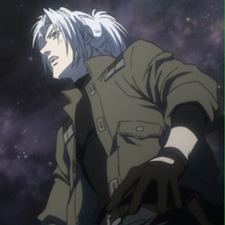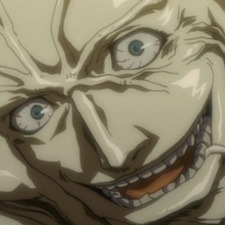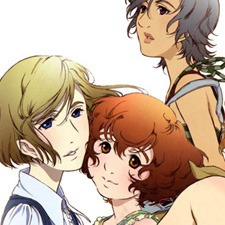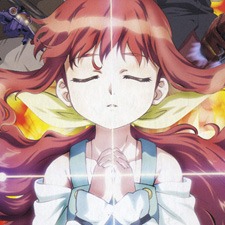
Moon Phase started out so very painfully. I don’t want to watch abandoned-by-his-mother Kouhei Morioka have a reluctant and awkward master-slave relationship with a teenager named Hazuki in the context of her vampirism. I especially don’t want to watch Hazuki be a brat (and that goes doubly when watching in English), bolstered by her shikigami pal, Haiji (who, speaking of dubs, surely has one of the most obnoxious voices in the history of the practice-that lisp just kills me). Isn’t all of this occult stuff sort of corny anyway?
Kouhei is a photographer who apparently can’t take pictures without ghosts appearing in them, despite his inability to sense them in any way. On assignment at Schwartz Quelle Castle for an occult magazine, he meets the neko-mimi sporting Hazuki who, as it turns out, needs a slave. She “kisses” him, but he is immune-a “vampire’s lover,” a term that begins your descent into the shows particular vampire lore. “Perfect daywalker”, anyone?
Since Hazuki is still convinced that the ritual is complete, she takes the opportunity to escape the captivity of Count Heinrich von Kinkell, which instigates a magical action-packed battle showing off one of the show’s strengths-compelling background music. Of course, having Hazuki out and about will not do, and even after they convert Elfriede, Kinkell’s daughter, to their cause, and defeat Kinkell himself, there are still others who wish to use Hazuki as a means to their own ends.

It’s actually at about this point that, if you’re still watching, the show starts to get more interesting. The majority of the main characters are presumed dead after a fire, but are, in fact, training/hiding in the mountains, preparing for further showdowns. Before this point, Kouhei was just your general bumbling loser sort of guy, but strengthening himself in the woods really brings a lot to his character-by which I mean, some sorely needed badassery.
The second half of the show also fleshes out Kaoru and Hikaru, Seiji and Kouhei’s family-arranged fiancées. In Hikaru’s case it’s fun, because she can be amusing and assertive. As for Kaoru, it’s sort of terrifying as it chronicles her devolution into a submissive, nyaaing cat girl obsessed with getting Kouhei to notice her over Hazuki.

My note on the art is simply this: fever cheeks. Rosy is one thing, but shining like that seems like it almost must be painful. I’ve never noticed it so prominently in other shows–the outright glare coming off of these girl’s faces is enough to make you want to slip them a thermometer. Other than that, the girls are clearly designed to make your moe-lovin’ insides all tingly, and ample opportunities are  taken to present them naked or in swimming suits.
taken to present them naked or in swimming suits.
The disks themselves are pretty plain in terms of extra features, but the plot summary booklets that come with the boxset are not mere plot summary booklets, but feature extensive interviews with the Japanese cast and crew, even down to Dmitri in Paris, who did the goofy opening song, “Neko-Mimi Mode.”
On the whole, Moon Phase is hard to recommend. If you like absurd comedic endings, then the last ep will make you giggle, but suffering through all of Hazuki’s moods in the meantime is probably not worth it when there are plenty of shows that are absurdly comedic throughout. Those looking for serious horror will not find any here, and Kouhei asking himself why he can’t get this loli-vampire out of his head is not compelling enough drama until things get serious up in the mountains. Moon Phase spends so much time waxing, and still manages to not be full enough.
Available: Now
Rating: TVPG






